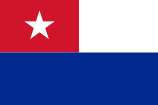 | |
| Bandera de la Estrella Solitaria[1] (Flag of the Solitary Star) | |
| Use | National flag and ensign |
|---|---|
| Proportion | 1:2[2] |
| Adopted | May 20, 1902[2] |
| Design | Five horizontal stripes of turquoise blue alternate with white with the red equilateral triangle based on the hoist-side bearing the white five-pointed star in the center. |
| Designed by | Miguel Teurbe Tolón and Narciso López |
 | |
| Use | Flag of the president of Cuba |
| Adopted | January 15, 1904 |
| The First Flag | |
 | |
| Use | Naval jack |
| Adopted | April 10, 1869 |

The national flag of Cuba (Bandera nacional de Cuba) consists of five alternating stripes (three navy blue and two white) and a cherry red chevron at the hoist, within which is a white five-pointed star. It was designed in 1849 and officially adopted May 20, 1902. The flag is referred to as the Estrella Solitaria, or the Lone Star flag.[1] It is in the stars and stripes flag family.
- ^ a b Chacón, Hipólito Rafael (2020-08-17). "The Global Legacy of Cuba's Estrella Solitaria (Lone Star Flag)" (PDF). North American Vexillological Association. Archived from the original (PDF) on 2020-08-17. Retrieved 2022-08-23.
- ^ a b Smith, Whitney. "flag of Cuba | Britannica". Britannica. Retrieved 2022-08-23.